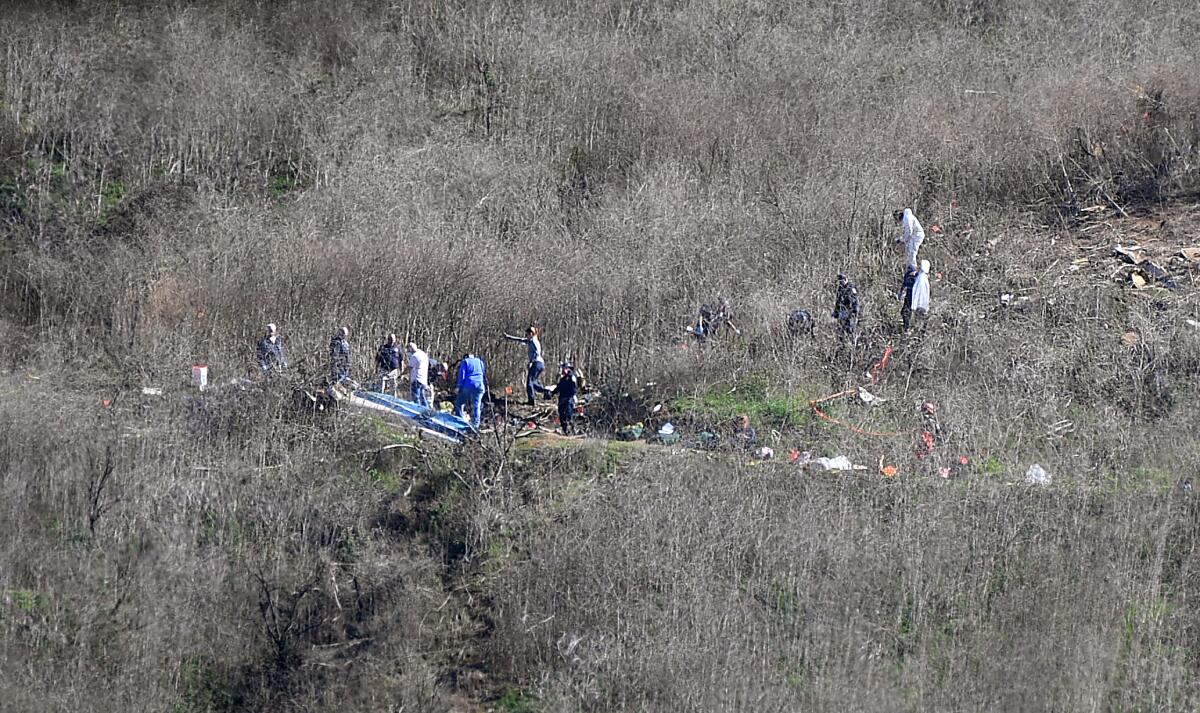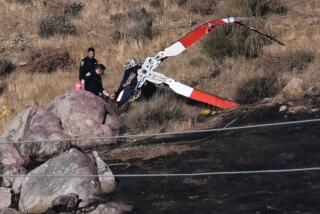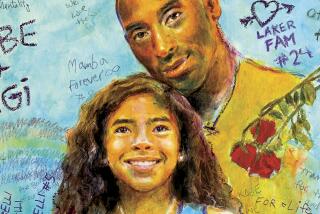Probe of Kobe Bryant crash will probably focus on fog, possible mechanical problems, experts say

- Share via
The investigation into the helicopter crash that killed Kobe Bryant, his daughter Gianna and seven others aboard a Sikorsky S-76B will probably focus on foggy weather conditions and potential mechanical problems, aviation experts and pilots said Sunday.
Visibility in the region was so poor at the time of the crash, which occurred shortly before 10 a.m. in Calabasas, that the Los Angeles police and county sheriff’s departments had grounded their helicopters.
Bad weather would not necessarily have prevented Bryant’s helicopter from flying, because it should have been equipped with instruments that allow pilots to fly in inclement conditions, experts said. But if not using the instruments, the pilot would have been operating the helicopter under visual flight rules, or VFR, which require good visibility.
An audio recording of an exchange between the pilot and air traffic controllers indicates that he was flying under visual flight rules, but that could not be confirmed Sunday night. At one point, the pilot tells a controller that he is “in VFR at 1,500” feet.
Bryant’s helicopter departed John Wayne Airport in Orange County at 9:06 a.m., passed over Boyle Heights and near Dodger Stadium, then circled Glendale before crashing in heavy fog, according to publicly available flight records and witness accounts.
Kurt Deetz, a former pilot for Island Express Holding Corp., the company to which the helicopter was registered, told The Times he thought the crash was likelier caused by bad weather than mechanical issues.
“The likelihood of a catastrophic twin-engine failure on that aircraft — it just doesn’t happen,” he said.
Deetz, who said he logged more than 1,000 hours in the helicopter that crashed Sunday, called its condition “fantastic.” Island Express follows a “very good maintenance program,” he added.
The helicopter that carried Bryant and the others was built in 1991 and was designed with twin turboshaft engines and seating capacity for two crew members and 12 passengers.
The model, in various iterations, has been flying since the 1970s and is a popular choice among corporate executives, celebrities and others. The helicopter has been used by air ambulance services and oil companies to ferry workers to offshore rigs.
The S-76 model had among the lowest number and rate of fatal crashes of all popular civilian helicopters in the United States from 2006 to 2016, according to a Los Angeles Times analysis of National Transportation Safety Board accident reports and Federal Aviation Administration data in 2018.
Of 12 popular models, the S-76 had the second-lowest rate of fatal crashes with 0.2 per 100,000 flight hours. The model was involved in just two fatal crashes during that time.
A Sikorsky S-76A went down in March 2013 in Louisiana, killing all three people on board. The NTSB concluded the crash was caused by a rotor blade fracture.
Eight people died in another Louisiana crash in 2009, when a Sikorsky S-76C struck a red-tailed hawk, fracturing the windshield and interfering with the craft’s fuel controls, an NTSB investigation found. The agency called on the FAA to issue regulations requiring that helicopter windshields be resistant to bird strikes.
Generally, however, the S-76 enjoys a good reputation.
“It’s well designed. It’s robust. It’s a sturdy helicopter. It’s why executives like to fly in helicopters like that — they have significantly fewer problems,” said aviation consultant William Lawrence, a retired Marine Corps colonel and helicopter test pilot and instructor.
Lawrence, an experienced accident investigator, said the possible causes of the crash run the gamut from engine problems to rotor failures to electrical malfunctions. He said investigators from the NTSB, which has dispatched a team to the crash site, should have little trouble determining whether it was a mechanical failure or weather-related, or both.
Even if the pilot had been flying on instruments, the helicopter could have experienced a mechanical problem.
“And if he is in the fog and on instruments and has an emergency, it makes recovery from that emergency far, far more difficult,” he said. “Any emergency is amplified when you can’t see your surroundings.”
The pilot’s name had not been released.
Chuck Street, executive director of the Los Angeles Area Helicopter Operators Assn., of which Island Express is a member, said the company’s primary business was transporting passengers from Long Beach to Avalon on Catalina Island. It also carried celebrities such as Bryant for private flights, he said.
“They had a very, very good safety culture,” Street said of the company. “Whenever I was over there or talking with their pilots ... the No. 1 priority was safety.”
Street said the pilot in the crash was instrument-rated and described him as “well trained and cautious.”
“He took what he did seriously,” Street said, declining to identify him. “The words that come up in my mind when I think of him: professional and cheerful.”
Even with training, fog can be perilous for helicopter pilots. Pilots with the Fresno County Sheriff’s Office won’t fly their helicopters if visibility is less than three miles, said Juan Reyes, a deputy sheriff pilot who has flown helicopters for the office for more than 12 years.
“Fog is obviously the worst situation you’d want to fly in.” he said. “[In] fog you have no visibility.”
When the Fresno County Sheriff’s Office does encounter fog, pilots will slow down, he said.
“The last thing you want to do is flying in at a high rate of speed, and then you fly into a fog bank or cloud,” Reyes said.
Deetz, who had flown Bryant on the same helicopter from 2014 to 2016, said that judging from a public record of the flight path and the wide debris field, it appeared to be traveling very fast just before impact, about 160 miles per hour.
After a 40-minute flight, Deetz added, the craft would have had about 800 pounds of fuel on board.
“That’s enough to start a pretty big fire,” he said.
Deetz said his “heart sank” when he learned of Sunday’s crash.
“In this business, when you hear about a crash like this, it’s a very surreal experience,” he said, recalling happier moments.
When Bryant retired from the NBA in 2016, he flew out of downtown Los Angeles in the same helicopter, wrapped in a gray and black paint scheme with his Mamba emblem on the side, Deetz said.
Bryant favored the S-76B, Deetz said, which he compared to “a Cadillac, a limousine — it’s limo-esque.” The model is favored by celebrities and known as comfortable and safe, he said. Its sister model, the S-76A, “is more like a work truck,” he said.
When he flew Bryant, Deetz said, the star was quiet: “It was always, ‘Hey,’ thumbs up, or sometimes nothing at all. He kept to himself. He would get in, get out, and that was it. There was no hugging, no backslapping — he was very professional.”
Deetz recalled one flight, on Father’s Day 2016: He was spending the day with his son when he got a call — could he fly Bryant to downtown Los Angeles?
Deetz brought along his son, who sat with him up front. Bryant was with his daughters in the back. He spotted Deetz’s son: “He’s a very private guy,” Deetz recalled, “but he noticed my son there and he said, ‘Hey little man.’ My son and I remembered that today.”
Times staff writers Ben Poston, Ben Welsh and Kiera Feldman contributed to this report.
More to Read
Sign up for Essential California
The most important California stories and recommendations in your inbox every morning.
You may occasionally receive promotional content from the Los Angeles Times.











